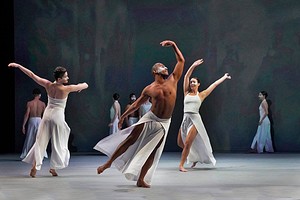Acclaim
Opera Theatre of St. Louis presents a musically outstanding 'Orfeo and Euridice

Christoph Willibald Gluck’s first “reform opera,” 1762’s “Orfeo and Euridice,” is a landmark, changing the direction of the art form. It’s based on the familiar myth of Orpheus, who went to Hades to rescue his beloved from death, with beautiful music and opportunities for dancers as well as singers. What’s more, it’s short, clocking in at just over two hours with an intermission. The mystery is that it isn’t produced more often.
Opera Theatre of St. Louis’ production, seen in its entirety Wednesday night (after a second-act cancellation June 9), is musically outstanding. The opera is largely carried by its Orfeo, mezzo-soprano Jennifer Johnson Cano, who brings a big, rich voice that’s flawlessly produced in both lyrical and fiendishly challenging coloratura passages. Dramatically, she was fully engaged, whether in mourning Euridice (she does a lot of that), charming the furies, or, finally, rejoicing. OTSL built its production around the St. Louis native, and it paid off.
Her Euridice is soprano Andriana Chuchman, who made her mark at OTSL as both Boonyi and India in Jack Perla’s “Shalimar the Clown” and has a beautiful, soaring voice. Her dancing was graceful. Chuchman was a supremely sympathetic Euridice, adjusting to her new life as a blessed spirit and grieving when Orfeo wouldn’t look at her, or explain why, on their passage out of the underworld.
Making her OTSL debut as Amore, the god of love, soprano Maria Valdes was utterly charming as a boyish figure who knows he’s cute. She wielded a lovely voice.
The chorus was outstanding, both in its singing and acting, moving well throughout. The excellent translation was by Amanda Holden and sung clearly by all, with the help of English diction coach Erie Mills.
In the pit, conductor Pierre Vallet led the 1859 French version of the score (supervised by Hector Berlioz) with idiomatic style. This split of the St. Louis Symphony Orchestra played this graceful music with skill and true artistry; particularly notable were associate principal oboe Philip Ross, in an onstage duet with Johnson Cano, and associate principal flute Andrea Kaplan, for her solo work in the “Dance of the Blessed Spirits.”
Stage director Ron Daniels’ production was a mixed bag. He had some good ideas (putting Ross onstage for the duet) but sent the ensemble into the house a little too often and seemed to be trying too hard to be hip.
One of his best ideas was to work with choreographer Katarzyna Skarpetowska and the Big Muddy Dance Company. Skarpetowska’s dances were effective and athletic, whether as the Furies, outraged at having to give up a soul, but unable to resist Orfeo’s voice, as the happy Blessed Spirits, or in enthusiastic celebration at the end. This production will be a welcome introduction to a fine local company for a lot of operagoers.
Set designer Riccardo Hernandez didn’t have much to do; the stage, covered by a dance floor, was nearly empty, with just a few roll-on pieces: a contemporary-style shrine with a giant portrait of Euridice, decked with flowers, black balloons and the obligatory teddy bears; the word “AMORE,” lit up. Much of the “scenery” consisted of projections by videographer Peter Negrini.
Emily Rebholz’s costumes were in a style that Daniels calls “heightened contemporary.” Orfeo and his friends seemed to belong to a motorcycle gang; the Furies wore long, red rain slickers over black leotards. (The dancers’ sleeveless dresslike tunics were more effective.) Euridice had an attractive white dress in Elysium, but her sleeveless, black, leather biker vest at the end was too much. Amore, in a “Love” T-shirt, boyfriend jeans and a backward baseball cap, sported large, fluffy wings with lights on them. Rebholtz really went over the top with some cheesy outfits in the finale.